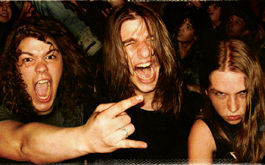home | metro silicon valley index | music & nightlife | band review

THAT GUY SLAYS ME: Audience members react to a rare Kerry King standup set at 'Thrash Metal Comedy Night.'
Thrash Compactor
Rick Ernst unearths thrash metal's Bay Area roots in A new documentary
By Gary Singh
DURING one scene from Get Thrashed: The Story of Thrash Metal, written and directed by Rick Ernst, Exodus members Gary Holt and Tom Hunting are casually recalling their role in how thrash metal started. With the Golden Gate Bridge hovering in the background, Holt and Hunting say they just basically took Iron Maiden, Judas Priest and Motorhead and then added a little bit of punk bands like Discharge and the Exploited. "And there you have it," Holt says.
Exodus, along with bands like Metallica, Slayer, Anthrax and Megadeth, collectively invented a brand-new genre in the early-to-mid-'80s, now universally known as thrash. Even those making the music had no idea where it was going, and most regular metal fans initially didn't get it. When Metallica's Kill 'em All first emerged, people were calling it "hardcore without the haircuts." Metal bands then became heavier, faster and more violent than anything else, with separate do-it-yourself scenes emerging in San Francisco, Los Angeles and New York. Crudely simplified, they took a hardcore punk attitude and combined it with an already fuming hatred for the glam metal bands of the same era. The music was ferocious and people in the crowd gleefully beat the shit out of each other while listening to it.
Get Thrashed is the first documentary that fully explores how all the madness began, told firsthand by the bands themselves. There are current interviews with dudes in Metallica, Slayer, Exodus, Anthrax, Megadeth, Testament, Death Angel and more, each yakking about the old days, as well as raw footage from the '80s depicting slam pits, blood, stage diving, broken bottles, parties, fliers and much more. Plus, folks from later bands like Slipknot, Pantera, Biohazard and Hatebreed remember how they themselves first discovered thrash, which particular albums changed their lives, or who beat up which glam metal poseur first.
Fans who weren't there in the '80s when all this began will get a full baptism into what it was like. On the other hand, if you did happen to grow up in the middle of it all, especially in the San Francisco or New York scenes, this film will take you back. Or if you were hardcore in those days and hated metal, you'll at least get a glimpse into where the thrashers were coming from during the whole crossover phase.
As expected, certain folks who were arrogant and full of themselves 25 years ago are still arrogant and full of themselves today. Dave Mustaine of Megadeth claims he was better and faster than anyone in Metallica and that he taught Slayer's Kerry King how to play, so therefore he's responsible for both those bands. The film also wonderfully showcases conflicting explanations of where thrash actually started. For example, Brian Slagel of Metal Blade Records curiously repeats over and over that it all began in Los Angeles (huh?), the reason probably being that his label was technically the first one to give Metallica and Slayer their starts. However, the film then cuts right to Kirk Hammett irritably dismissing Slagel's version and declaring that Metallica was originally thrown out of L.A. because nobody there understood what the band was playing. "[Thrash] began in San Francisco," Hammett pronounces, as if ending all possible argument on the matter.
San Francisco.com Real Estate
Moving to the Bay Area just became easy. Let San Francisco.com show you all the homes currently for sale.
San Jose.com Real Estate
Relocating to San Jose or Silicon Valley? Let San Jose.com introduce you to some expert area real estate agents.
But thrash is thrash and the film covers it all—not just in America. German bands like Kreator, Sodom and Destruction share their stories too, and throughout 90 minutes of bonus interview footage, current bands like Municipal Waste talk about the different scenes in Germany, Canada, Britain and more. Even better, it's a rare chance to see Kerry King and Tom Araya from Slayer attempting to defend the days when they used to wear evil black makeup, something they don't usually talk about. "We just wanted to be whatever was not Hollywood," King explains.
Send a letter to the editor about this story.
|
|
|
|
|
|
